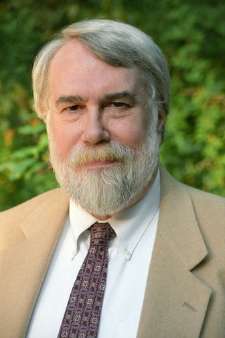|
Back
And Heaven and Nature Sing New York
Avery Fisher Hall, Carnegie HYall
04/17/2013 - & April 18, 19, 20, 2013
Christopher Rouse: Prospero’s Rooms (World Premiere)
Leonard Bernstein: Serenade (After Plato’s “Symposium”)
Charles Ives: Symphony No. 4
Joshua Bell (Violin)
Members of the New York Choral Consortium, Kent Tritle (Director), New York Philharmonic Orchestra, Eric Huebner (Piano), Case Scaglione (Second Conductor), Alan Gilbert (Music Director/Conductor)

C. Rouse (© Jeffrey Herman)
How simple it would be to classify this week’s Philharmonic concert–one of the most interesting, if not the most stunning concerts of 2013–as an “all-American” concert, with three Yankee composers, a New York-residing soloist and conductor. But more important is that each of the three works has a literary meaning as important as the music composed.
In fact, the trio of works come from writers who enveloped themselves in words almost as much as music. Christopher Rouse is inspired by mythology and literature, his Prospero’s Rooms generated from Edgar Allen Poe. The Harvard-educated Leonard Bernstein frequently showed off his education with music inspired by Voltaire, the two Biblical Testaments, by Shakespeare, Auden, Aristophanes and here, by Plato. Yale-educated Charles Ives kept to America, to the Transcendentalists and the pantheistic 19th Century freethinkers.
All were masters of their craft. And Christopher Rouse, the Phil’s composer-in-residence, showed his absolute mastery of the orchestra in a ten-minute work (New York Philharmonic Commission) that was like a dazzling mini-concerto for orchestra. Yes, Mr. Rouse was inspired by Masque of the Red Death, a story from which Debussy also tried an opera. But the divisions of the different-color rooms were seamless, somewhat horrifying, an orchestral tour de force.
Mr. Rouse is such an orchestral perfectionist that he spent a few hours with NY Phil percussionist Chris Lamb to get exactly the right sound for the divisions of the rooms. He finally decided on the perfect recipe: a large tuned gong, an equally large tuned bell plate and an enormous tam-tam all struck together twelve times over the ten minutes.
But not even hearing this, one feels the color and music of the rooms, beginning with the lowest notes of the contrabassoon developing into a crescendo of brass and kind of mini-theme from the flute. But now Mr. Rouse works into his own genius, of translating that flute piece into percussion soli, and bringing in the whole orchestra.
The theme of the work of course suggests Bartók’s Bluebeard, and much of the orchestration suggests these varying colors. But Mr. Rouse never goes too far, and within ten minutes–ten fascinating minutes with just the amount of material to fill the time–one feels enough of this passion, this glory which the NY Phil can bring to fruition.

J. Bell (© Marc Holm)
That was a world premiere, but Bernstein’s Serenade was a rarity. It sounded vaguely like mainstream Bernstein, some jazz was toward the end, and was anything but an homage to Plato. The Symposium was, of course a dinner party, and Bernstein, that extrovert socialite, could have chosen his own dinners to celebrate. For nothing is particularly Greek (or philosophical). It is simply a good quasi-concerto.
Joshua Bell seemed to have great fun echoing the orchestra, announcing the fugues, working duets and giving all five movements their due. Not a single cadenza per se, but the whole piece was a lyrical romp, and Mr. Bell’s tone gets better and better as the years go on.

A. Gilbert (© NYPhilharmonic.com)
While all three works were fascinating, my own choice went to Charles Ives’ incredibly difficult Fourth Symphony. In the past, it has taken up to three conductors to get the orchestra somewhat on the right track. Here, Mr. Gilbert conducted the orchestra, members of the New York Choral Consortium, and a consort of strings way up in the second balcony. But the Phil’s Assistant Conductor, Case Scaglione, had to conduct parts of the orchestra at times, with the choir coming in on the lapping movements.
Mr. Gilbert has had some moments these years with music that will be remembered always. Ligeti’s Grand Macabre was one such (despite bad staging), and this Ives is certainly another. It is a salmagundi, a crazy quilt of marches, ragtime, pop songs, hymns, and an orchestra pressing down all those pieces at one time. No, the strings weren’t all bowing in unison, the brass blared in and out, and the whole thing was Ives’s universe which–on the surface–was pure chaos. On the other end, that chaos was a universe in itself.
To Ives, God was not in his heaven, all was notright with the world. But since God was the world, and all the madness, beauty, sanctity, clownishness could be forgiven as part of God’s practical joke, his happy anarchy.
With all the insanity, Ives gave one blatant key to this magnificent work. At the end of a rather academic fugue, based on one hymn tune, the trombone comes out ofits depths to finish with a reverent line from Joy to the World. “And heaven and nature sing” is the line. This was Ives’ credo, and Mr. Gilbert gave it all the awesome power he possessed to make it a reality.
Harry Rolnick
|